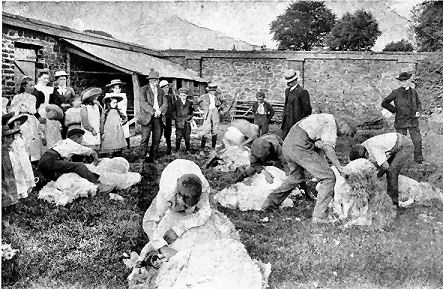

|
Shearing for the Woollacott's always started on the first Thursday in June, this being a tradition that they brought to West Yeo from "outover", as the other side of Exmoor was referred to in those days. Another tradition from there was that for shearing white jackets and trousers were always worn. If the shearing lasted more than one day, and it usually did, then these clothes had to be washed every evening, so that the next morning they were once again spotless, with no signs of the inevitable stains of yolk, marker tar, and dirt.
In the thirties the work was done using hand shears, and a rate of eight sheep an hour was considered good going before the arrival of mechanical clippers. at West Yeo at this time there were some 400 to 500 sheep, so neighbours, and friends and relatives from Exmoor would join in to the number eight to ten, all lined up around the walls of the barn. Richardses, Woollacott's, Frenches and Reg Webber from Adworthy were among them. Later in the forties and fifties an engine was installed which could provide power for mechanical clippers, but many still came for the occasion. Even during petrol rationing a certain taxi driver from Porlock was able to bring over a carload. It was not until 1961 that electricity finally reached West Yeo. If the weather was wet, the sheep were kept in overnight to be dry, but if the weather was dry in the morning, they would be allowed out for a couple of hours grazing, as the fuller the sheep the easier the shearing. A start was usually made at 10am, giving time for all the helpers to arrive. Mid morning produced tea and rock buns, and at lunchtime there would be a salad lunch, with ham, mutton, and hot potatoes, followed by trifle, apple pies, and fruit salads. It was also a tradition that the lettuce for the salad was specially grown for the occasion by Mr and Mrs Hunt of Littlebourne, who used to walk the mile to West Yeo with it on the day. After the days work was done, there was a full cooked meal for all. Beer was available throughout the day - "workingmen's beer" until the evening, but after supper Vicars Beer came out. Vicars beer was so called because it only came out when the vicar or doctor called, or on special occasions. It was not unusual on the last day of shearing for some to leave for home until after midnight. The sheep would be penned near the barn, and a local man, Charlie Middleton, would have the job of catching each ewe and sitting her on her tail for each shearer. Reg Rodd, a retired butcher, tied the fleeces. Once shorn, ewes had to be marked by an iron dipped in black, the Woollacott's mark was naturally a W. An essential part of the day was the bucket or tin bath of water with ferns in it. This was better than soap for cleaning yolk (the liquid on a sheep's skin) from the hands, it also prevented rash on the hands for those susceptible to it. With the ewe on her tail shearing began on the stomach, and then from the head down all over and round the stomach. Very few adjustments to the ewe's position were needed. Thin ewes could however be a problem due to their bony condition and to the fact that the thinner the ewe, the more agile she was, and the more likely to struggle. Shearing at West Yeo in the thirties was not only a key event in the farming year, but also an important social event. Previous Last Edited 03/07/2006 Copyright © 2000-2006 Witheridge Unless otherwise indicated on the page in question, the photographic images reproduced on this site belong to the Witheridge Archives, and, as such may not be reproduced for commercial purposes without written permission. However, you are welcome to use any of the photographs belonging to the archive for personal and/or non-commercial use. Any material shown as not being owned by the archive may not be reproduced in any form without first receiving written permission from the owner of the material in question. |


